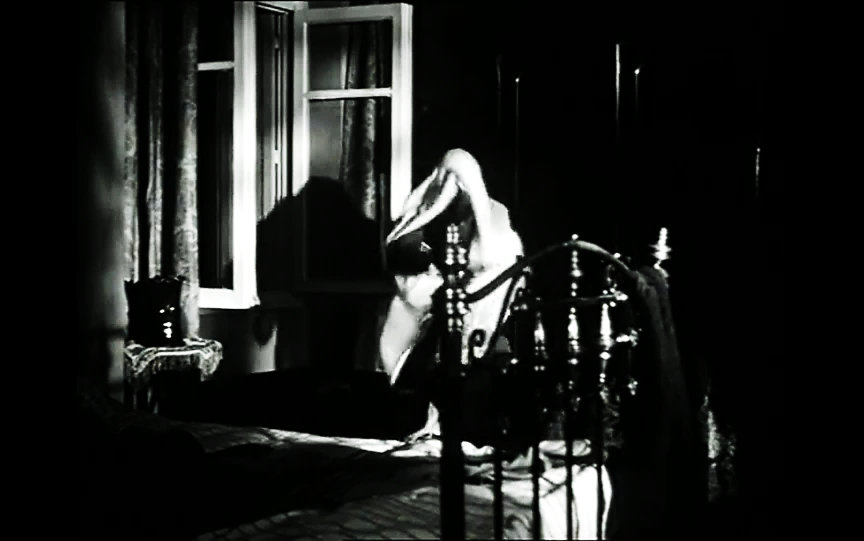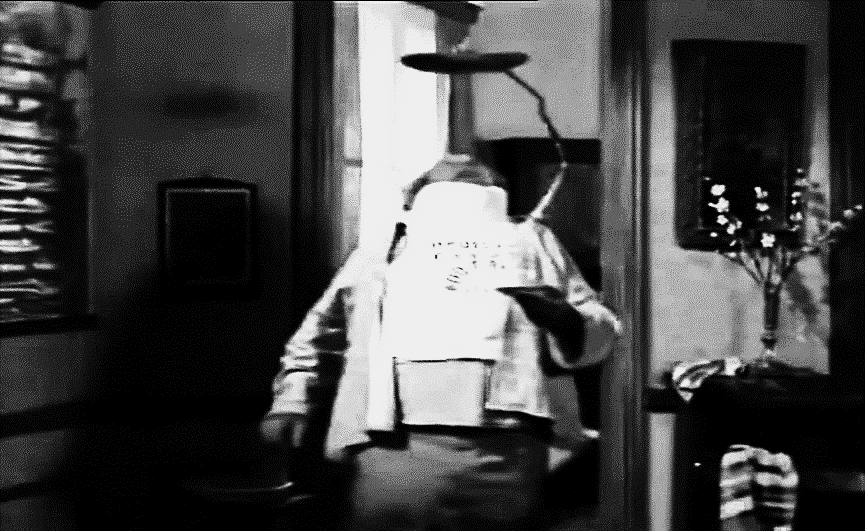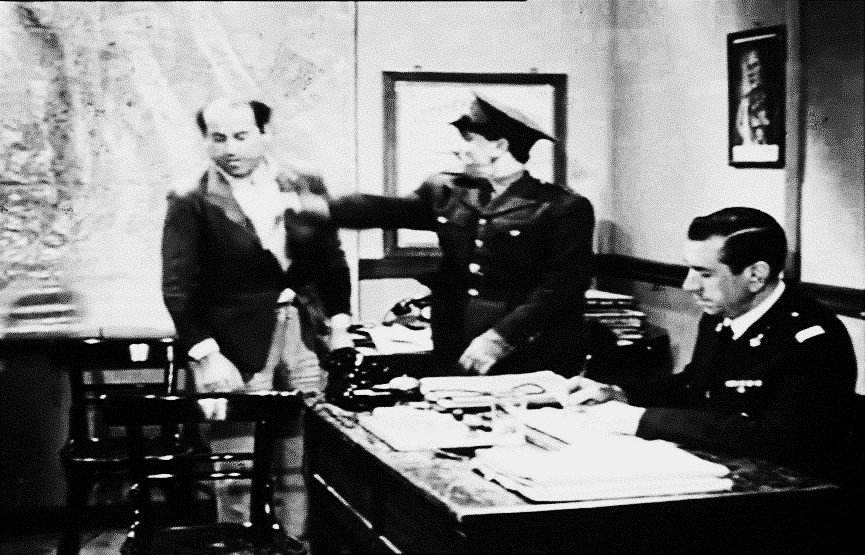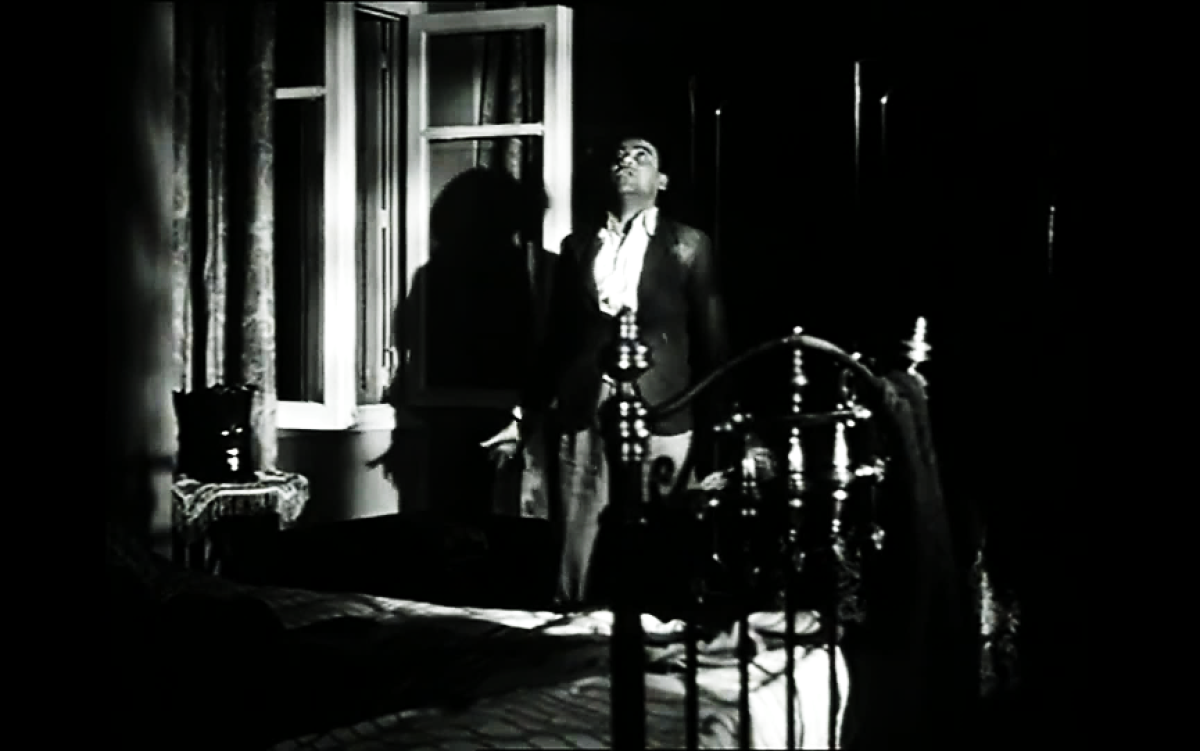Hysterical Avowal:
Thanasis Veggos' Overappropriation of a Gesture
07 February 2024
Orestis Tzirtzilakis University of Oxford
Ghosts – Veggos
A medium shot introduces a man standing outside a house window. He examines his surroundings but looks exhausted. No one is around, so he enters the room. A cut to a wider medium shot shows the inside of the apartment, while the camera remains at eye level. In the new shot, the man’s body is hidden behind a woven window curtain, invisible. Suddenly, he slips and the curtain falls over him, covering his body (fig. 1). Momentarily he looks like a Halloween ghost, the veil hovers for no more than a second as he nervously removes his ghostlike costume. The camera stays still. The man swiftly frees himself and, now unveiled, enacts a very eerie posture (fig. 2). Immediately after, he comes to his senses, he looks around one last time, and the scene ends.
The actor playing the burglar is Thanasis Veggos, in Alekos Sakellarios’ The Policeman of the Sixteenth Precinct (Greece, 1959). Sakelarios’ film was a successful farce comedy, coming fourth in the local box office returns of that year. The script was adapted from a theatrical play performed in the summer of 1958 at the Park Theatre of Athens, written by Sakellarios and Christos Giannakopoulos. Its narrative focuses on the story of three working-class friends, Vaggelis (Stavros Ksenidis), Ilias (Kostas Chatzichristos) and Thomas (Thanasis Veggos), who, in dire need of money, decide to steal from Lampros (Dionysis Papagiannopoulos), Vaggelis’ boss. The latter, while seemingly the owner of a café, is also a cold-hearted fence who sells stolen items. So, the three friends decide to rob Lampros: Ksenidis stays with his boss to avoid suspicion, Chatzichristos dresses up as a policeman and patrols the area near the apartment while keeping an eye on Veggos, who, finally, enters the apartment and steals the items.


Figures 1 & 2: Stills from The Policeman of the Sixteenth Precinct [Ο Ηλίας του 16ου].
Dir. Sakellarios, Alekos; Prod. Finos Film. Greece, 06 April 1959, 35 mm, B&W, Film, 86’.
A comic twist happens when Chatzichristos is mistaken for an actual policeman while patrolling the area and gets caught up in a quarrel between an Athenian bourgeois couple and their maid (Athanasiou 2001: 221–222). Chatzichristos’ group moves to the local police department; meanwhile, an actual policeman arrests Veggos and accompanies him to the same site. There, Chatzichristos, simulating the policeman, first extracts an avowal from Veggos and, then, slaps him fiercely. These slaps became notorious in the history of Greek cinema and many, including the perpetrator, Chatzichristos, have accounted for their ferocity (Delaportas 2019: 55).
More importantly, these slaps would become a symbol taken up by many of Veggos’ later film personae (Soldatos 2023: 122). Indeed, in Panos Glykofrydis’ and Dinos Katsouridis’ collaborative film Thanasis in the Land of Slapping (Greece, 1976), scenes of ‘slapping,’ divided between two allegorical sections, are used to criticise processes of forced avowal entailed in the authoritarian regimes of modern Greece. The first section, directed by Katsouridis, refers to the Metaxas’ dictatorship (1936–1941) and the second one, directed by Glykofrydis, to the Greek Junta (1967–1974). In Thanasis in the Land of Slapping, slaps turn into cruel beatings, and Veggos’ body becomes the medium untangling the implicit political violence of these two regimes.
Interestingly, Sakellarios’ 1959 film was the set where Veggos met with Katsouridis, who, at the time, worked as a cameraman (Soldatos 2023: 84). Perhaps it was these famous slaps that inspired the directors to make their later film, even dressing Veggos, in Glykofrydis’ section, in another ghost-like suit: a futurist-looking plaster cast (fig. 3). This suit is most probably a reference to Thanassis Valtinos’ short story The Plaster Cast (1970) in which the dictator of the Greek Junta, Georgios Papadopoulos, is allegorically criticised for his ‘habit of referring in his speeches to Greece as a patient in need of urgent hospitalisation’ (Papanikolaou 2021: 13). Indeed, in this latter film one can see how oppressive regimes, as in the Junta of Valtinos’ story, biopolitically arrange non-normative bodies so as to need a ‘cure.’ Moreover, Veggos, in performing as the main culprit of this ‘land of slapping’ is inhabited metonymically by such precarious lives that were forcefully ‘hospitalised.’

Figure 3: Still from Thanasis in the Land of Slapping [Ο Θανάσης στη χώρα της σφαλιάρας]
Dir. Glikofridis, Panos; Katsouridis, Dinos; Prod. Finos Film. Greece, 15 March 1976, 35 mm, Colour, 90’.
The persistence of both films in using Veggos' quirky performances as a depiction of subjugation is deliberate. Vasilis Veggos, his son, once recounted in an interview that his grandfather was a member of the National Liberation Front (EAM), a political alliance formed during the Second World War in Greece to resist the Axis Occupation in 1941 (Soldatos 2023: 44–46). During the Greek Civil War (1944–1949) members of EAM were stigmatized by the established government, and many were sent, after 1947, to three concentration camps: Makronisos, Trikeri, and Yioura each dedicated to a specific group of ‘delinquents’ (Panourgia 2009: 89). By the end of the 1940s, the then adolescent Veggos was about to begin his military service. Instead, he was sent to the second Special Battalion of Soldiers on the camp specialized in the gathering of suspicious individuals drafted to the military forces, the prison island of Makronisos (ibid.). Veggos was treated as a potential deserter and a threat to the state. From very early on he was himself recognized as in need of a certain kind of ‘hospitalisation’.
It was in Makronisos that he encountered, among many other intellectuals and artists, Nikos Koundouros. It was also there that he thrived as an improvisation theatre actor in some of Koundouros’ makeshift plays. Interestingly, many have recounted that it was on that prison island where Veggos developed his famous cinematic traits: facial tics, fear of dust and disorder, convulsive movements, and the tendency to run (Soldatos 2023: 43–44).
Alethurgy: Displacement
In a medium shot, we see Chatzichristos, dressed as a policeman. He orders Veggos to present himself in front of the police lieutenant:
‘Hey, why don’t you tell me? Are you normal?’ ‘No,’ responds Veggos.
‘Poor guy! He is not normal at all! Will you do it again?’ ‘No, I will never do it again.’
‘He will not, he says it all by himself’ and continues ‘Were your children hungry? Was your mother sick?’ Questions to which Veggos, fatigued, responds ‘Yes’.
After a brief conversation with the lieutenant, the latter requests Chatzichristos to accompany Veggos to the detention cells. The shot opens up, preparing the spectator for action, and Chatzichristos fiercely slaps Veggos (fig. 4). A first slap, then a second, a third; ‘I know what I am doing mister lieutenant!’ he exclaims. When they find their way outside, it's dark, and both hang in front of a white wall resembling the shadowy figures of a cinema screen. They start walking slowly, and, after a while, they run away.

Figure 4: Still from The Policeman of the Sixteenth Precinct [Ο Ηλίας του 16ου].
Dir. Sakellarios, Alekos; Prod. Finos Film. Greece, 06 April 1959, 35 mm, B&W, Film, 86’.
It must be mentioned that a considerable iconography of ‘slaps’ already existed in Greek cinema of the 1950s. Another example, again directed by Sakellarios, is Maidens Cheeks (Greece, 1959), a title that can be translated literally as ‘beating is heaven-sent’ (το ξύλο βγήκε απ’ τον παράδεισο), and in which slaps inform again a series of gendered and class relations. Moreover, Veggos himself had been slapped repeatedly already in his first film appearance in Koundouros’ Magic City (Greece, 1954). However, the slaps from The Policeman of the Sixteenth Precinct are different from these other depictions because they make explicit a certain condition of power, vividly associating themselves with the Foucauldian discourse of avowal. One of the most perspicuous elements of the film, from the quarrel of the Athenian bourgeois couple where the maid does not avow of an assumed, and staged, crime, to Chatzichristos’ slapping Veggos after his confession to being a criminal, is the destabilization of the practice of avowal.
In the 1980s Michel Foucault framed his philosophical project in terms of both the forms of knowledge that transform subjects into objects of domination, and of the techniques through which these same subjectivities can actively engage with the formation of the self (Foucault 2016: 25). He named the unfolding of this engagement with the formation of the self as techniques of the self and grounded them in, what he called, forms of ‘veridiction:’ the ways of telling the truth, and their transformative power in relation to the self (Foucault 2010: 41–42). The ways of telling the truth inform ‘alethurgic forms,’ i.e. how subjectivities become places where truth is both manifested and produced (Foucault 2011: 3).
Avowal is a privileged mode of Western ‘alethurgic forms,’ which Foucault spent significant time exploring during the 1980s. Formative of his inquiry on how avowal made truth both manifested and produced in modernity was the question of why doctors, in the nineteenth century, demanded their patients to confirm with words what they had already expressed through symptoms. Foucault’s most exemplary case is the psychiatrist François Leuret and his extraction of avowal after the torture of his patient, Mr A. In this case, Foucault gives the following definition for (modern) avowal: avowal is a ‘verbal act through which the subject affirms who he is, binds himself to this truth, places himself in a relationship of dependence with regard to another, and modifies at the same time his relationship to himself’ (Foucault 2014: 17).
What is verbal in avowal is not necessarily expressed with words. Foucault’s (modern) avowal is not limited to a religious or legal understanding of the term. It opens up to a variety of practices and is not restricted to religious confession. Even in religious practices, Foucault makes clear that ‘avowal’ has emerged in different forms throughout history, from a performative act observed in the ritual of penance in antiquity (exomologesis) to its later, medieval, reformulation in monastic institutions and the permanent verbal avowal of the self (exagoreusis).
Leuret’s case further elucidates how avowal became important for practices distinct from religious ones, as a dramaturgy necessary for the proper function of the judicial and psychiatric system (ibid.: 210). Without avowal, says Foucault, the category of the ‘criminal,’ or the ‘mad,’ subject would inexorably fracture. Indeed, confession turned out to be a wound within the judicial and psychiatric systems of the nineteenth century. Avowal necessitates a relation in which subjects bind themselves to a truth while placing themselves in a relationship of dependence on the holder of that truth. The judicial system of the nineteenth century fractured when these same subjects, for instance diagnosed with monomania, confessed in ways that disturbed the mechanisms of power that had structured them.
Foucault had spoken about a similar ‘disturbance’ a few years earlier, in his lectures at the Collège de France in 1973–1974: the insurrection of the hysterics. In the nineteenth century, the French neurologist Jean-Martin Charcot became fixated on solving the mysterious condition of hysteria. However, Charcot’s patients were soon thought to be simulating their disease, especially during the so-called ‘Tuesday Lessons,’ in which Charcot re-enacted the supposed symptomatology of hysteria through the bodies of his patients in an amphitheatre filled with curious onlookers. In Foucault’s words, this ‘problem of simulation’ was the way ‘in which a true symptom is a certain way of lying and the way in which a false symptom is a way of being truly ill [. . .] those who were mad actually responded with the question of falsehood to this psychiatric power that refused to pose the question of truth.’ (Foucault 2006: 136, italics added). For Foucault, the hysterics in avowing the truth imposed on them by the doctors accelerated its effects, exposing, in the process, its fragility.
Although Foucault treats patients who were horrifically abused with a romantic sense of ‘subjectivity,’ his idea was that patients like Marie Wittman or Augustine followed Charcot’s orders in a way that theatricalized the ‘truth’ of their disease. Hysteria, as well as monomania, demonstrated how the clinical or judicial truth was not a universal necessity but a ‘universality’ historically and culturally defined.
Hysteria/Effect
Hysteria is a condition historically and culturally defined, and, at the same time, one that, throughout history, has ruptured the way truth becomes manifested in assumedly ‘hysterical’ subjectivities, a case surprisingly relevant to Veggos’ performances discussed earlier.
To start with, Veggos is ‘slapped’ by Chatzichristos belatedly, only after his avowal. This belatedness may signify both Chatzichristos and Veggos’ attempt at simulating their avowal, to make sure that subjugation is visible in the face of power. At the same time, this act emphasises how inexcusable, and unnecessary, this violence is; an uncomfortable spectacle. Yet, there is another intrinsically peculiar and untimely moment in which Veggos acts completely out-of-order and which could recall a performative overdramatization of a violent ‘slap.’ It is the moment when he enters the apartment of Ksenidis’ boss, Lampros, after he is comically unveiled from the curtain. In his ghost-like costume, Veggos enacts an eerie posture (fig. 2). The posture is eerie because, like a ghost haunting from a recent past, it reminds us of the gestures acted out by Charcot’s hysterics.
‘Hysteria’, derived from the ancient Greek ‘hystera’ (i.e. the uterus), has had a long ‘official’ history in which the female body, from ancient Egypt to Victorian England, is subjugated to a set of discourses that aims at pathologizing and neurologizing its undiagnosable emotional or physical states. From a wandering womb to a demonically possessed body and a mind predisposed to deception, such history consists of a divergent and complex series of techniques that aim to dominate and regulate the female body. These series of dominations do not unfold only via medical discourses; they can be traced through their intersection with religious and judicial forms of knowledge. Hence, in the seventeenth century, in an attempt to classify hysteria as a medical noun, and through the intersection of these disciplines, the modern understanding of the disease was constituted (Arnaud 2015: 4).
In this ‘official’ history there is a certain typology of gestures aimed at subjugating the female body. For instance, in 1603 the physician Edward Jorden attempted, in court, to dismiss the potential demonic possession of a girl, Mary Glover, calling it instead a case of ‘hysterica passio’ or ‘suffocation of the mother’ (Scull 2012: 15). He maintained that the illness of the girl could be observed in a variety of bodily symptoms; their cause being noxious vapours that, beginning from the uterus, would affect the normal function of the brain (Shetty et al. 2020: 313). One particularly distressing symptom was her tendency to lean her body backwards, a pose that Charcot would later name the ‘hysterical arch’ (Scull 2012: 21). These same postures, and their systematized reenactment by the patients, helped in generating the narrative of ‘simulation’ that turned to undermine Charcot’s authority. Moreover, hysteria’s potential to be representable, and at the same time subversive, was profoundly explored by artists. Salvador Dalí drew the ‘arch’ in 1937, Hélène Vanel re-appropriated it in her performance at the International Surrealist Exhibition (1938) and Louise Bourgeois transferred this ‘arch’ into sculpture in 1993 as a manifestation of corporeal fragility (Marshall 2020: 77–78).
A ‘hysteriform archive’ can be extracted from within the ‘official’ history of hysteria, undermining the limits of the representability of such history. At least this is how Jonathan Marshall understands the archives assembled from the scarce appearances of hysterical texts and performances within the centuries, and their ability to disturb the ‘official’ representation of madness. In his own words: ‘signs of hysteria-like choreography might therefore act as a heuristic for identifying moments where historical experience itself challenges language and representation’ (ibid.: 62).
Following the seventeenth century, when medical diagnostic procedures sought to physicalize diseases through neurology, many have traced strange, and singular, performances of male hysteria in these archives. In a similar gest, Charcot and his students, attempting to define hysteria neurologically, sought out its symptomatology and performances not only in women but also in (working class) men (Micale 2008: 130). By the beginning of the twentieth century many neurologists took up Charcot’s project but proposed that these men were instead simulating their symptoms. Other medics suggested that these symptoms were based on psychological trauma rather than a neurologically detectable condition. A prevalent idea was that these supposedly ‘traumatic’ disorders were fueled by a ‘pension neurosis,’ in which the workers, and then the soldiers in the wars that were accelerating throughout the first half of the twentieth century, would simulate obscure symptomatologies to escape their appointed position–simultaneously arguing about their ‘femininity’ (Lerner 2001: 150–151).
In the concentration camp of Makronisos, after the official end of the Civil War, Veggos began to assemble his own unique set of tics and gestures, some of them unnervingly reminiscent of the ‘hysteriform archive.’ If The Policeman of the Sixteenth Precinct is an unexpectedly Foucauldian film, its iconography, which later, as we saw, traversed into other films, did more than just refer to the political (ab)use of confession through torture, the famous ‘slappings.’ It also entailed a paradoxical moment where hysteria met avowal in the body of an actor whose own performances aimed at laying bare the official representation of madness. Veggos imbued his unique acting style with an effort to present how a body (including his own) becomes subjugated under techniques of domination. By overappropriating a set of neurotic gestures, Veggos’ performances indicate a form of hysteria that challenges the way truth is forcibly manifested in the formation of the modern Greek self. Hence, The Policeman of the Sixteenth Precinct was one of the first moments in Greek Cinema when a popular farce comedy made hysteria a platform where medicalizing discourses of power could be critically overappropriated.
[All translations from Greek were done by the author.]
References
Arnaud, Sabine (2015). On Hysteria: The Invention of a Medical Category between 1670 and 1820. Chicago: The University of Chicago Press.
Athanasiou, Gianna (2001). Ελληνικός κινηματογράφος (1950-1967): Λαϊκή μνήμη και ιδεολογία. Finatec AE: Athens.
Delaportas, Makis (2019). Θανάσης Βέγγος. Kathimerines Ekdoseis: Athens.
Foucault, Michel (2006). Psychiatric Power: Lectures at the Collège de France, 1973–74. Basingstoke: Palgrave Macmillan.
Foucault, Michel (2010). The Government of Self and Others: Lectures at the College de France, 1982–1983. New York: Palgrave Macmillan.
Foucault, Michel (2011). The Courage of the Truth (The Government of Self and Others II): Lectures at the Collège de France, 1983–1984. Basingstoke: Palgrave Macmillan.
Foucault, Michel (2014). Wrong-Doing, Truth-Telling: The Function of Avowal in Justice. Chicago; London: University of Chicago Press.
Foucault, Michel (2016). About the Beginning of the Hermeneutics of the Self: Lectures at Dartmouth College, 1980. Chicago: The University of Chicago Press.
Lerner, Paul (2001). ‘From Traumatic Neurosis to Male Hysteria: The Decline and Fall of Hermann Oppenheim, 1889-1919.’ In Micale, Mark; Lerner, Paul, eds. (2001.) Traumatic Pasts: History, Psychiatry, and Trauma in the Modern Age, 1870–1930: Cambridge: Cambridge University Press.: 140–171.
Marshall, Jonathan W. (2020). ‘Traumatic Dances of “the Non-self”: Bodily Incoherence and the Hysterical Archive.’ In Braun, Johanna, ed. (2020) Performing Hysteria: Images and Imaginations of Hysteria. Leuven: Leuven University Press: 61–83.
Micale, Mark S. (2008). Hysterical Men: The Hidden History of Male Nervous Illness. Cambridge, MA; London, England: Harvard University Press.
Panourgia, Neni (2009). Dangerous Citizens: The Greek Left and the Terror of the State. New York: Fordham University Press.
Scull, Andrew (2012). Hysteria: The Disturbing History. Oxford: Oxford University Press.
Shetty, Siddharth; Chandini, S; Fernandes, Sharol; Safeekh, A. (2020). ‘Hysteria: A Historical Perspective.’ Arch Med Health Sci, 8 (2): 312–5.
Soldatos, Giannis (2023). Ένας άνθρωπος παντός καιρού. Athens: Aigokeros.
Papanikolaou, Dimitris (2021). Greek Weird Wave: A Cinema of Biopolitics. Edinburgh: Edinburgh University Press.

Orestis Tzirtzilakis is a DPhil candidate in Medieval and Modern Languages (Modern Greek) at the University of Oxford. He studied Philosophy and the Arts at the University of Patras and University of Warwick. His doctoral thesis, titled 'A Cultural Genealogy of Modern Greek Hysteria, 19th–20th Century', focuses on ‘minor’ ways hysteria has challenged both an ‘official’ history of the disease and a culturally specific narration of Greekness.
